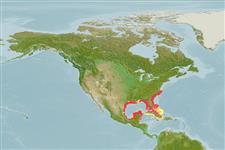Environment: milieu / climate zone / depth range / distribution range
Ecology
Marine; demersal; depth range 11 - 101 m (Ref. 89891). Subtropical; 37°N - 18°N, 98°W - 74°W
Western Atlantic: North Carolina to Cape Canaveral in northeastern Florida, USA and the entire Gulf of Mexico, including Florida Keys.
Size / Weight / Age
Maturity: Lm ? range ? - ? cm
Max length : 30.0 cm TL male/unsexed; (Ref. 7251)
Prefers hard bottoms at depths of about 55 m.
Life cycle and mating behavior
Maturity | Reproduction | Spawning | Eggs | Fecundity | Larvae
Robins, C.R. and G.C. Ray, 1986. A field guide to Atlantic coast fishes of North America. Houghton Mifflin Company, Boston, U.S.A. 354 p. (Ref. 7251)
IUCN Red List Status (Ref. 130435: Version 2024-1)
Threat to humans
Harmless
Human uses
Tools
Special reports
Download XML
Internet sources
Estimates based on models
Preferred temperature (Ref.
123201): 22.6 - 27.2, mean 24.8 °C (based on 208 cells).
Phylogenetic diversity index (Ref.
82804): PD
50 = 0.5312 [Uniqueness, from 0.5 = low to 2.0 = high].
Bayesian length-weight: a=0.01738 (0.00993 - 0.03041), b=3.03 (2.88 - 3.18), in cm total length, based on LWR estimates for this species & (Sub)family-body (Ref.
93245).
Trophic level (Ref.
69278): 3.5 ±0.53 se; based on food items.
Resilience (Ref.
120179): Medium, minimum population doubling time 1.4 - 4.4 years (Preliminary K or Fecundity.).
Fishing Vulnerability (Ref.
59153): Low vulnerability (20 of 100).
Nutrients (Ref.
124155): Calcium = 99.2 [38.8, 196.2] mg/100g; Iron = 1.06 [0.58, 1.99] mg/100g; Protein = 18.3 [16.5, 20.0] %; Omega3 = 0.394 [0.254, 0.665] g/100g; Selenium = 24.7 [13.5, 47.7] μg/100g; VitaminA = 17.3 [5.8, 59.1] μg/100g; Zinc = 0.83 [0.60, 1.22] mg/100g (wet weight);
